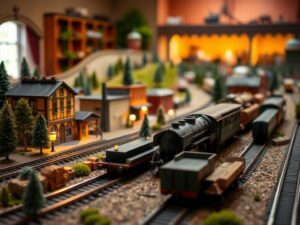How to Troubleshoot DCC Issues in HO Scale Layouts
How to Troubleshoot DCC Issues in HO Scale Layouts
How to Troubleshoot DCC Issues in HO Scale Layouts
Welcome aboard fellow railfans! This blog post is dedicated to our adventurers taking their HO scale layouts into the exciting realm of Digital Command Control (DCC). DCC brings your model trains to life like never before â imagine controlling individual locomotives, switching them seamlessly between functions, and creating intricate movement patterns. Sounds awesome, right?
But like any complex system, DCC can sometimes throw a wrench in your tracks. Today, we’re going deep into troubleshooting common DCC issues you might encounter with your HO scale setup. Whether youâre new to DCC or a seasoned veteran facing a puzzling problem, this guide is your comprehensive toolkit for getting back on track.
Understanding the Basics: A Quick DCC Refresher
Before we dive into the troubleshooting steps, let’s quickly revisit the fundamentals of DCC. Remember, it involves replacing traditional analog wiring with a digitally controlled system.
Think of your DCC setup like a bustling city transportation network.
-
The Command Station: This is your central hub â the dispatch control for all things train-related. It generates the digital signals that your locomotives understand.
-
The Track Bus: This is your road system, where power flows from the command station to your rolling stock. Remember to maintain clean connections!
-
DCC Decoder: Each locomotive you want to control digitally requires a decoder â a miniature âtranslatorâ nestled inside. It interprets DCC signals and turns them into instructions for the engine’s motor, lights, and sound (if equipped).
Common DCC Problems in HO Scale
- No Power at All
- Issue: Your locomotives simply arenât moving, and none of your track sections light up. Itâs like a blackout on your railway!
- Troubleshooting Steps:
- Power Check: Ensure the power source is plugged in and turned on. If you’re using a separate power supply, double-check its output voltage matches your command stationâs requirements (usually between 16 and 18 volts AC). A loose power cord or a faulty connection at either end can also be culprits.
- Fuse Check: Your command station might have a fuse. Consult the manual for location and replacement procedures.
- Command Station Problems: A malfunctioning command station could be the root cause. Test with a different DCC system, if possible.
- Train Runs at Only One Speed (Or Skips Speed Increments)
- Issue: Your locomotives seem to have locked onto one speed, and changing the throttle has no effect, or they jump erratically between speeds.
-
Troubleshooting Steps:
- Decoder Contact Problems: Gently check the decoderâs soldered connections within the locomotive for loose solder points. A dirty track or damaged electrical pick-up shoes (those metal contact pieces) can also interfere with signal reception.
- Speed Table Mismatch: In some decoders, you might need to adjust the speed table setting on your command station if your train isnât responding correctly to throttle adjustments. Consult your decoder’s manual for specific instructions.
- DCC Locomotives Fail to Respond or are Non-functional:
- Issue: You power up the DCC system, but some (or all!) of your equipped locomotives donât react at all. This can be frustrating!
-
Troubleshooting Steps:
- Check Decoder Status Lights: Some decoders have indicator lights to signal their operation status. If a light isn’t flashing or solid when the locomotive is powered on, it might be malfunctioning.
- Short Circuit Detection: Modern command stations often have short-circuit detection circuits that automatically isolate locomotives if a fault is detected. Carefully check the track sections and connections near any problem areas. Disconnect individual locomotives from the bus to isolate any troublesome equipment.
- Unreliable Signal Reception
- Issue: Sometimes, your DCC system might work fine in one spot but act up in others. It’s as if your signals are experiencing “dead zones”
- Troubleshooting Steps:
- Wire Integrity: Carefully examine your track bus wiring for loose connections, kinks, or worn insulation. Repair any damaged wires to ensure proper signal flow. A weak connection between sections of track can disrupt DCC signals.
HO Scale-Specific Considerations:
-
While the troubleshooting concepts above apply broadly to all scales, HO scale layouts tend to be more intricate. Pay attention to your wiring scheme â multiple power rails (for each direction), loops, sidings, and yard tracks can create complexities that need careful consideration.
- Larger layouts require higher quality DCC systems. The more complex your layout, the more powerful command station and robust wiring system you’ll need for reliable performance.
-
Space constraints are real! With HO scale’s smaller size, space is often a premium. Ensure your components have ample room for air circulation to prevent overheating issues, which can also impact DCC operation.
General Tips for Effective DCC Troubleshooting:
-
Systematic Approach: Follow a logical progression, starting with the power supply and moving towards your locomotiveâs decoder. Don’t randomly change settings or jump between solutions; this just adds to the confusion!
- Isolation Techniques: If you suspect an issue with a particular section of track, try disconnecting that section and seeing if the problem persists. This can help pinpoint the problematic area.
-
Reference Manuals: Consult both your command station and decoder manuals religiously! They contain valuable troubleshooting guides and diagrams specific to your setup. Don’t forget those model railroad forums and online communities; thereâs a wealth of knowledge and shared experiences among fellow hobbyists who have faced similar challenges.
Get Creative with Your Problem-Solving:
DCC isnât just about fixing issues; it’s also about pushing the boundaries of creativity!
-
Use software to create detailed block diagrams and simulate signal flow within your layout. This can be invaluable for visualizing complex wiring setups and pinpointing potential trouble spots.
-
Keep Learning! Model railroading, especially DCC, is a constantly evolving world. Stay curious, keep exploring new technologies and techniques, and embrace the learning process. The more you experiment and tinker, the better equipped youâll become to tackle even the most perplexing DCC problems with confidence.
Ready to unleash your inner engineer and command a vibrant world of miniature trains?
With this guide as your roadmap, your HO scale layout will be chugging along smoothly in no time! Happy railroading!




